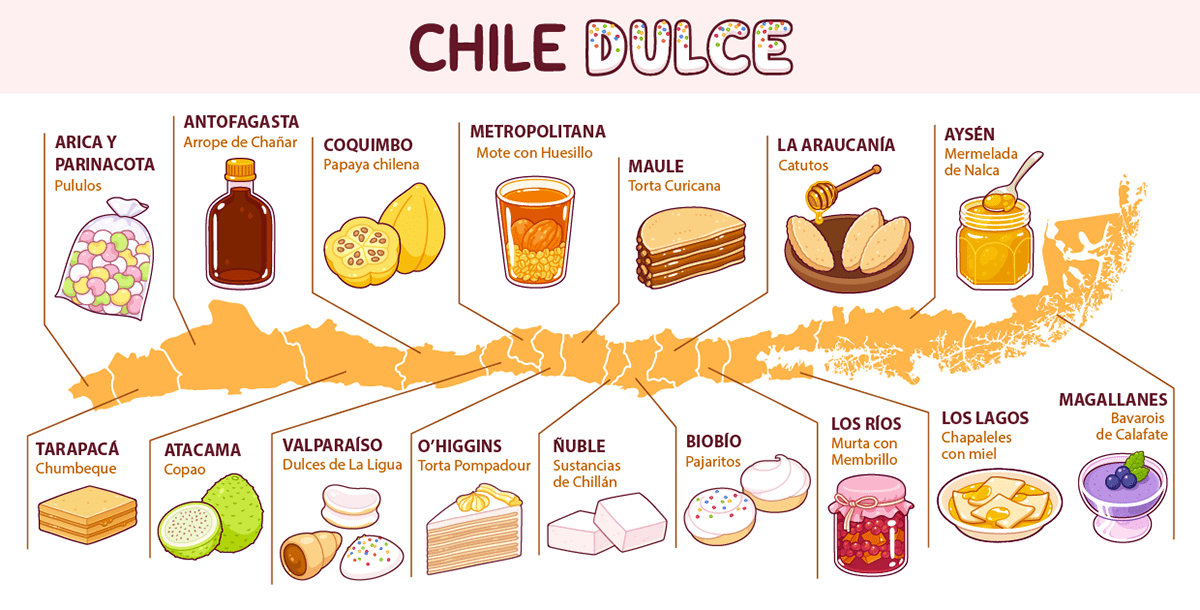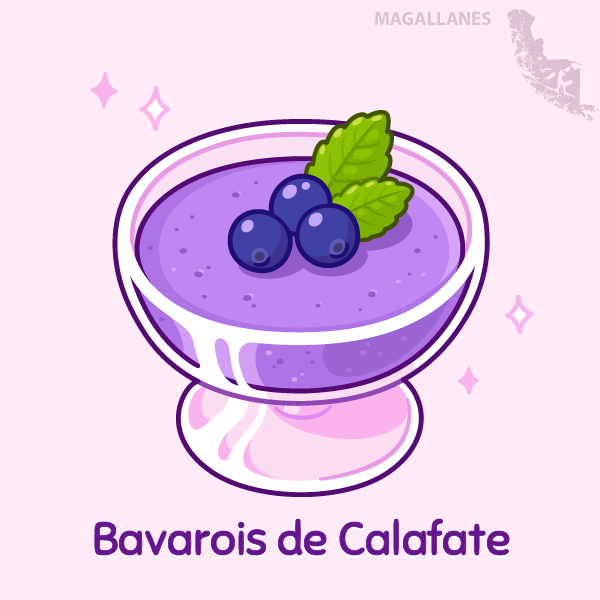
Traditional sweets and desserts from all 16 regions of Chile.



Arica y Parinacota
Pululos (or polulos) are inflated cereal puffs that are sold by the bag in Northern Chile, Bolivia and Peru - in areas traditionally populated by the Aymara indigenous people.
Pululos (or polulos) are inflated cereal puffs that are sold by the bag in Northern Chile, Bolivia and Peru - in areas traditionally populated by the Aymara indigenous people.
Tarapacá
Chumbeque is a classic treat from Iquique. It's a dense brick of nougat-like sweet confection layered with honey, lemon syrup or other flavors. The recipe was created in early XX century by a Chinese immigrant who married a Chilean pastry chef and opened a small family business, combining Cantonese sweet traditions with local ingredients.
Chumbeque is a classic treat from Iquique. It's a dense brick of nougat-like sweet confection layered with honey, lemon syrup or other flavors. The recipe was created in early XX century by a Chinese immigrant who married a Chilean pastry chef and opened a small family business, combining Cantonese sweet traditions with local ingredients.
Antofagasta
Chañar is a tree that grows in the dry climate of northern Argentina and Chilean North. Arrope de chañar is a sweet, dark syrup made from its fruit that supposedly has medicinal properties
Chañar is a tree that grows in the dry climate of northern Argentina and Chilean North. Arrope de chañar is a sweet, dark syrup made from its fruit that supposedly has medicinal properties



Atacama
Copao is the fruit of a wild cactus endemic to Chile that only grows in the Atacama desert 🌵 It is pretty acidic, tastes somewhere between a lemon and a kiwi, so many people prefer to eat it with sugar.
Copao is the fruit of a wild cactus endemic to Chile that only grows in the Atacama desert 🌵 It is pretty acidic, tastes somewhere between a lemon and a kiwi, so many people prefer to eat it with sugar.
Coquimbo
Chilean papaya grows in and around the towns of Coquimbo and La Serena. It's different from its tropical counterpart: smaller, yellow, and often cooked in some way rather than eaten raw. You can try candied papayas, papayas in syrup, and all kinds of papaya preserves and sweets in Coquimbo
Chilean papaya grows in and around the towns of Coquimbo and La Serena. It's different from its tropical counterpart: smaller, yellow, and often cooked in some way rather than eaten raw. You can try candied papayas, papayas in syrup, and all kinds of papaya preserves and sweets in Coquimbo
Valparaíso
La Ligua is a small town in Valparaíso region that is home to about a dozen types of traditional Chilean pastries known collectively as "dulces de La Ligua". Pictured here: Cachitos, Chilenitos and Almejas.
La Ligua is a small town in Valparaíso region that is home to about a dozen types of traditional Chilean pastries known collectively as "dulces de La Ligua". Pictured here: Cachitos, Chilenitos and Almejas.



Region Metropolitana de Santiago
The most Chilean thing ever: Mote con huesillo! This traditional drink/snack is enjoyed all over the country, but it seemed fitting to pinpoint it to the capital. This is a sweet nectar made from dried peaches (huesillo) mixed with cooked wheat (mote). Served chilled and eaten with a spoon 🍑
O'Higgins
Torta Pompadour de plátano Is the signature cake of Rancagua. A variation on mille-feuille (milhojas) it has many thin sheets of pastry with alternating layers of manjar and banana flavored whipped cream 🍌
Torta Pompadour de plátano Is the signature cake of Rancagua. A variation on mille-feuille (milhojas) it has many thin sheets of pastry with alternating layers of manjar and banana flavored whipped cream 🍌
Maule
Torta Curicana is a traditional cake that originates from the city of Curicó. Layers of thin, crispy pastry are filled with manjar (dulce de leche, milk caramel). It can be flavored with orange or lúcuma, include walnuts or almonds.
Torta Curicana is a traditional cake that originates from the city of Curicó. Layers of thin, crispy pastry are filled with manjar (dulce de leche, milk caramel). It can be flavored with orange or lúcuma, include walnuts or almonds.



Ñuble
In Chile marshmallows are called "Sustancias" (literally: "substance") The city of Chillán was famous for its sustancias that were made by local Catholic nuns. The gelatin was extracted from chicken bones (hence: "sustancia de ave"🐔) in a long, labour-intensive process.
In Chile marshmallows are called "Sustancias" (literally: "substance") The city of Chillán was famous for its sustancias that were made by local Catholic nuns. The gelatin was extracted from chicken bones (hence: "sustancia de ave"🐔) in a long, labour-intensive process.
Biobío
Pajaritos ("Little birds" 🐤) are little sweet buns topped with meringue, sprinkles optional. They are traditionally prepared for September holidays, though you can find them all year round at the market in Concepción.
Pajaritos ("Little birds" 🐤) are little sweet buns topped with meringue, sprinkles optional. They are traditionally prepared for September holidays, though you can find them all year round at the market in Concepción.
La Araucanía
Catutos (mültrün in mapudungun) are a traditional mapuche dish. Made of cooked wheat grains that are ground until they resemble paste, mixed with butter and salt, and formed into rounded diamond shapes that are then boiled or fried. Served with honey or homemade jam 🍯
Catutos (mültrün in mapudungun) are a traditional mapuche dish. Made of cooked wheat grains that are ground until they resemble paste, mixed with butter and salt, and formed into rounded diamond shapes that are then boiled or fried. Served with honey or homemade jam 🍯



Los Ríos
Murta (Chilean guava) is a sweet red berry that grows in abundance in Valdivian rainforest. A common way to preserve it is by boiling with sugar together with quince (Membrillo).
Murta (Chilean guava) is a sweet red berry that grows in abundance in Valdivian rainforest. A common way to preserve it is by boiling with sugar together with quince (Membrillo).
Los Lagos
Chapaleles are traditional dumplings from Chiloé island that can be either savory or sweet. The sweet version doesn't contain potatoes (usually) and is rectangular rather than round in shape. Served with honey!
Chapaleles are traditional dumplings from Chiloé island that can be either savory or sweet. The sweet version doesn't contain potatoes (usually) and is rectangular rather than round in shape. Served with honey!
Aysén
"Nalca" is another name for Chilean Rhubarb. Not closely related to its European namesake, this plant reaches 2m tall. Here in Valdivia it's considered a salad vegetable: we eat it raw with salt; but it can also be cooked with sugar to make jams and other things you would normally make from rhubarb.
"Nalca" is another name for Chilean Rhubarb. Not closely related to its European namesake, this plant reaches 2m tall. Here in Valdivia it's considered a salad vegetable: we eat it raw with salt; but it can also be cooked with sugar to make jams and other things you would normally make from rhubarb.

Magallanes
Calafate is a "superfood" berry native to Patagonia, so calafate jellies, jams and sweets are a specialty of this region.
Calafate is a "superfood" berry native to Patagonia, so calafate jellies, jams and sweets are a specialty of this region.




